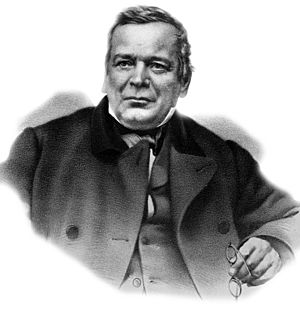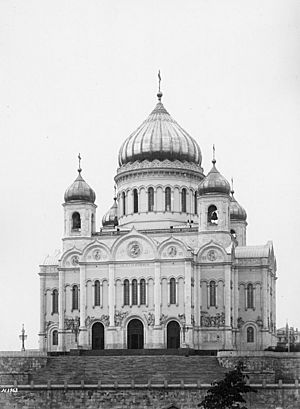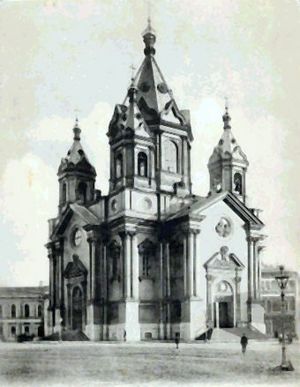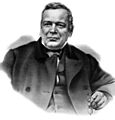Konstantin Thon facts for kids
Quick facts for kids
Konstantin Andreyevich Thon
|
|
|---|---|
 |
|
| Born | October 26, 1794 |
| Died | 25 January 1881 (aged 86) Saint Petersburg
|
| Nationality | Russian Empire |
| Occupation | Architect |
| Buildings | Cathedral of Christ the Saviour |
Konstantin Andreyevich Thon, also known as Ton (Russian: Константи́н Андре́евич Тон), was a famous architect in Imperial Russia. He lived from 1794 to 1881. He worked for Emperor Nicholas I. Thon designed many important buildings in Russia. Some of his most famous works are the Cathedral of Christ the Saviour, the Grand Kremlin Palace, and the Kremlin Armoury in Moscow.
Contents
Early Life and Education
Konstantin Thon was born in Saint Petersburg. His father was a German jeweller. Konstantin was one of three brothers who all became well-known architects.
He studied at the Imperial Academy of Arts from 1803 to 1815. His teacher was Andrey Voronikhin, a famous architect. Voronikhin designed the Kazan Cathedral in St. Petersburg.
After his studies, Thon traveled to Rome, Italy. He studied Italian art and architecture there from 1819 to 1828. When he returned to Russia, he became a member of the Imperial Academy of Arts in 1830. He later became a professor there in 1833. In 1854, he was made the head of the architecture section at the academy.
A New Russian Style
Thon first became famous for his beautiful designs inside the Academy building. In 1827, he showed the emperor his plan for St Catherine Church. This design was special because it was the first in the Russian Revival style.
Emperor Nicholas I liked this new style. He felt that Russian architecture should have its own traditions. Thon's church design became a model for many other churches built in St. Petersburg and across Russia.
Russian-Byzantine Architecture
Designing the Cathedral of Christ the Saviour
In 1830, Thon created his most important design: the Cathedral of Christ the Saviour in Moscow. He used a style called Russian-Byzantine Revival. This style was meant to make the new church look like older cathedrals in the Moscow Kremlin.
Some other architects did not like this style. They wanted the cathedral to be built in the Neoclassical style. However, the emperor personally approved Thon's design. Thon and his students worked on the cathedral for 50 years, until Thon's death in 1881.
Other Churches and Buildings
From 1836 to 1842, Thon oversaw the building of another large church. This was the Presentation to the Temple church for the Semenovsky regiment in St. Petersburg. He then designed many more churches and cathedrals in the Neo-Russian-Byzantine style. These were built in towns like Sveaborg, Yelets, Tomsk, Rostov-on-Don, and Krasnoyarsk. He even put some of his designs into a book called Model Album for Church Designs (1836).
The Grand Kremlin Palace
From 1838 to 1851, Thon worked on the Grand Kremlin Palace and the Kremlin Armoury in Moscow. The Grand Kremlin Palace is a huge building. It has 700 rooms and halls with very rich decorations. It was built to show how powerful the Russian state was.
Thon's design for the palace was bold. It included parts of older buildings that were already there. The palace has been used as a home for Russian emperors, Soviet leaders, and now the Presidents of the Russian Federation. At the same time, Thon also helped turn the old Izmaylovo Estate into a home for veterans of the Napoleonic Wars.
Later Years and Legacy
Thon's last major projects were the Nikolaevsky railway stations in Moscow and Saint Petersburg. These were built from 1849 to 1851. Thon used new building methods for these stations, like large pieces of steelwork. But he cleverly hid the modern look with Venetian-style fronts and medieval clock towers. Both stations are still standing today, though they have been changed over time.
After Emperor Nicholas I died, Thon's health declined. He could not work on many new projects, except for the great cathedral in Moscow. He passed away in St. Petersburg in 1881.
Some people at the time did not like Thon's architecture. Later, during the Soviet era, many of his churches were destroyed. This included all his churches in St. Petersburg and the Cathedral of Christ the Saviour. However, after the Soviet Union ended in 1991, people became interested in his work again. The Cathedral of Christ the Saviour was even rebuilt.
Images for kids
See also
 In Spanish: Konstantín Thon para niños
In Spanish: Konstantín Thon para niños




